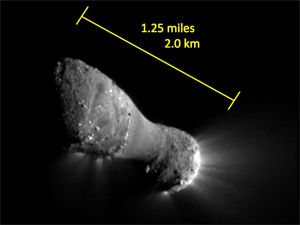Scientist analyzes the nucleus of comet Hartley 2
June 17, 2011

907-474-5823
6/17/11
Nearly one year ago, a repurposed NASA spacecraft flew by the comet Hartley 2. As a result, a multitude of high-resolution images were gathered over 50 days that allowed scientists to understand the nature of the comet’s surface and its hidden interior.
University of Alaska Fairbanks scientist Don Hampton was a key member of the mission to Hartley 2; he’s an optics expert that helped create the highly sensitive telescope, camera and infrared spectrometer that flew on the spacecraft. Hampton, the optical science manager at Poker Flat Research Range, is now analyzing data from the mission.
The bowling-pin-shaped Hartley 2 is a mass of ice and dust and is more than one mile long. The comet is dynamic, with ice, water vapor and carbon dioxide emitting from the comet’s nucleus through cracks and fissures on the surface. Analysis of the nucleus and its likely composition is the crux of an article published this week in the journal Science. Hampton is a co-author of the article.
“We basically had no data about what comet nuclei were like before space missions,” Hampton said. “When you look at the comet nucleus very closely, you can see what features on the surface correspond with these jets of gases. The reason why we’re focusing on the nucleus of Hartley 2 is that it is a very active comet and you can really look at this correlation in detail.”
The cameras aboard the spacecraft, repurposed for the Extrasolar Planet Observation and Deep Impact Extended Investigation mission, collected more than 70,000 images of Hartley 2 as it traveled to and from the comet in the fall of 2010. With the amount of data now available to scientists, Hampton is confident colleagues will continue to examine these images for telltale clues about Hartley 2’s make-up and unique behavior.
“Comets are the detritus, or the crumbs, from the formation of the solar system,” Hampton explained. “They give us a snapshot into the history of our solar system.”
As for the spacecraft, it is still floating in space and operational. Hampton believes the spacecraft will be repurposed and used again for another mission in the near future. The on-board telescope may still be positioned to look at far-off features in the galaxy.
ADDITIONAL CONTACTS: Don Hampton, Poker Flat Research Range optical science manager, 907-455-2256 or via email at dhampton@gi.alaska.edu. Marmian Grimes, UAF public information officer, at 907-474-7902 or via e-mail at mlgrimes@alaska.edu.
NOTE TO EDITORS: A photo of the comet is available online at www.uafnews.com.
ACCESS THE ARTICLE HERE: http://www.sciencemag.org/.
AH/6-17-11/254-11


